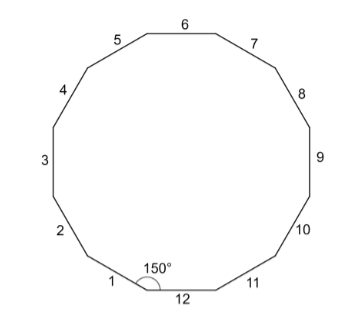
A regular polygon has angles of size 150 degrees each. How many sides does the polygon have?
Answer
546.9k+ views
Hint: We will look at the definition of a regular polygon. We will see some examples of regular polygons and also the properties of a regular polygon. We will find the measure of the exterior angle using the given measure of the interior angle. We will use the property of the exterior angles of a regular polygon to find the number of sides of the regular polygon.
Complete step by step answer:
A regular polygon is defined as a polygon that has all the sides of equal length and all the angles of the same measure. An equilateral triangle is a regular polygon that has three sides. A square is a regular polygon that has four sides.
In a regular polygon, the sum of an interior angle and its exterior angle is $180{}^\circ $. We will use this property to find the measure of the exterior angle of the regular polygon given in the question. Its interior angle has measure $150{}^\circ $. Therefore, the exterior angle has measure $180{}^\circ -150{}^\circ =30{}^\circ $.
Regular polygons have the property that the sum of all its exterior angles is $360{}^\circ $. Using this property, we can see that
$\text{number of sides}=\dfrac{\text{sum of exterior angles}}{\text{measure of one exterior angle}}$
Substituting the respective values, we get the following,
\[\begin{align}
& \text{number of sides}=\dfrac{360~{}^\circ }{30{}^\circ } \\
& \therefore \text{number of sides}=12 \\
\end{align}\]
Therefore, the number of sides of the regular polygon with interior angle $150{}^\circ $ is 12. This regular polygon looks like the following,

Note: The sum of the interior angles of this regular polygon will be $150{}^\circ \times 12=1800{}^\circ $. It is useful to know the relation between the interior angles, the exterior angles and the number of sides of a regular polygon. There is a formula to find the sum of interior angles of a polygon using the number of sides. This formula uses the fact that we can divide a regular polygon into triangles.
Complete step by step answer:
A regular polygon is defined as a polygon that has all the sides of equal length and all the angles of the same measure. An equilateral triangle is a regular polygon that has three sides. A square is a regular polygon that has four sides.
In a regular polygon, the sum of an interior angle and its exterior angle is $180{}^\circ $. We will use this property to find the measure of the exterior angle of the regular polygon given in the question. Its interior angle has measure $150{}^\circ $. Therefore, the exterior angle has measure $180{}^\circ -150{}^\circ =30{}^\circ $.
Regular polygons have the property that the sum of all its exterior angles is $360{}^\circ $. Using this property, we can see that
$\text{number of sides}=\dfrac{\text{sum of exterior angles}}{\text{measure of one exterior angle}}$
Substituting the respective values, we get the following,
\[\begin{align}
& \text{number of sides}=\dfrac{360~{}^\circ }{30{}^\circ } \\
& \therefore \text{number of sides}=12 \\
\end{align}\]
Therefore, the number of sides of the regular polygon with interior angle $150{}^\circ $ is 12. This regular polygon looks like the following,

Note: The sum of the interior angles of this regular polygon will be $150{}^\circ \times 12=1800{}^\circ $. It is useful to know the relation between the interior angles, the exterior angles and the number of sides of a regular polygon. There is a formula to find the sum of interior angles of a polygon using the number of sides. This formula uses the fact that we can divide a regular polygon into triangles.
Recently Updated Pages
Master Class 12 Business Studies: Engaging Questions & Answers for Success

Master Class 12 Economics: Engaging Questions & Answers for Success

Master Class 12 English: Engaging Questions & Answers for Success

Master Class 12 Maths: Engaging Questions & Answers for Success

Master Class 12 Social Science: Engaging Questions & Answers for Success

Master Class 12 Chemistry: Engaging Questions & Answers for Success

Trending doubts
Which places in India experience sunrise first and class 9 social science CBSE

Fill the blanks with the suitable prepositions 1 The class 9 english CBSE

Write the 6 fundamental rights of India and explain in detail

Difference Between Plant Cell and Animal Cell

What is pollution? How many types of pollution? Define it

What is the full form of pH?




